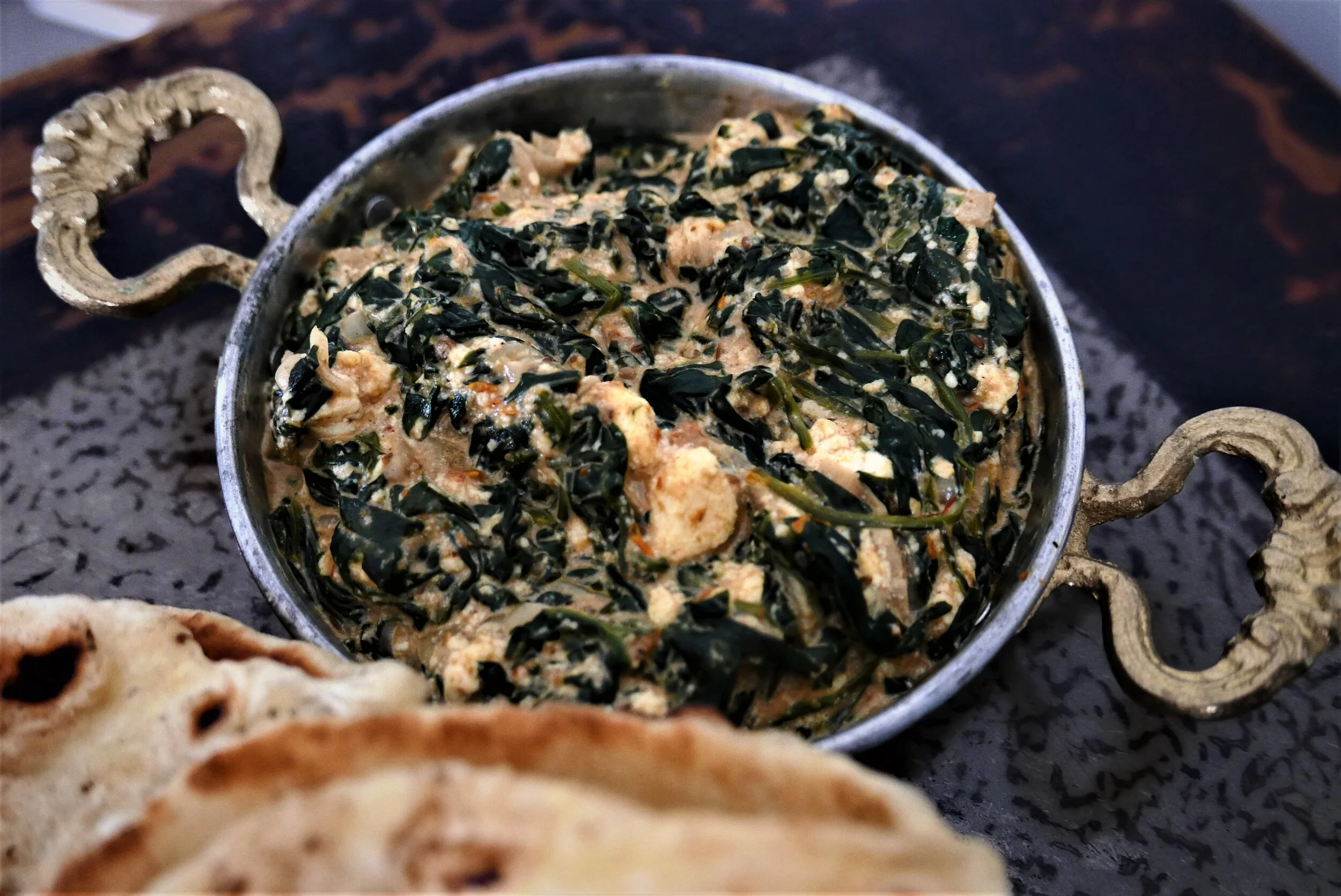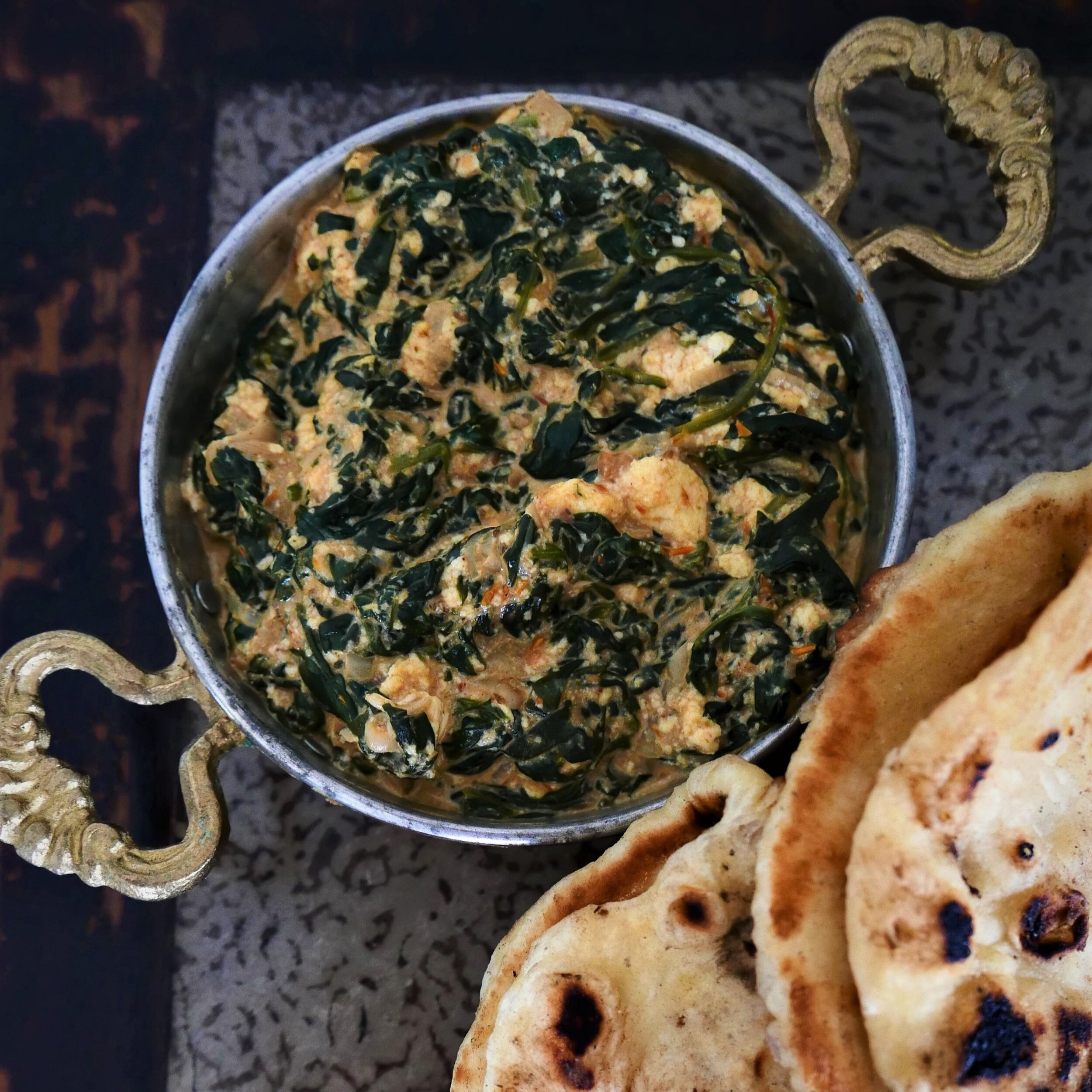explore the world through the universal language of food
Chunky Palak Paneer with Stove Top Naan
The Recipe
Serves: 4 people
Preparation: 15 minutes
Cooking Time: 30 minutes
Eating Time: depends on how hungry you are
“Possibly of North Indian origins, palak paneer is a dish supposedly developed by Mughals, a powerful Muslim dynasty that ruled over parts of the Indian subcontinent from the early 16th century to the mid-19th century.”
Indian food. I crave it. Often.
Especially my all time favourite dish - Palak Paneer.
Palak Paneer is originally a Punjabi vegetarian dish but is now found in variations all over India. It is a spinach curry dish with tomatoes, a mix of spices, onions and paneer (a simple rennet free cheese). You can find my paneer recipe here - it takes but a moment to make and just needs to be strained and pressed over night. If you don't have the time or can't find paneer at your local market, cottage cheese will do the job just fine.
Rather than blending the spinach like a curry, how it usually comes, I have actually left it chunky so it is like a thick stew. Team it with some simple naan bread (it's so easy to make from scratch!) and you have your Indian food cravings sorted.
INGREDIENTS
PALAK PANEER
600g baby spinach
4 tbsp vegetable oil
½ tsp cumin seeds
1 tsp fenugreek
1 tsp chilli powder
1 tsp ground turmeric
2 tsp garam masala
120g / 1 yellow onion, finely sliced
20g / a thumb sized piece of ginger, peeled
20g / 3-4 cloves of garlic, peeled
100g / 1 tomato
80g/ 4tblsp cream
2 tbsp lemon juice
150g paneer
STOVE TOP NAAN
3g/1 tsp instant yeast
180mls/ ¾ cup warm water
7g / 2tsp caster sugar
¼ tsp baking powder
300g plain white unbleached flour
2 tsp fine sea salt
15g/ 2.5tsp olive oil
50g/ 3tblsp yoghurt
METHOD
Grind the spices until fine, set aside
In a food processor blend the tomato, garlic and ginger until it resembles a nice smooth paste
In a large saucepan, bring salted water to the boil and have a bowl of iced water on stand by
Drop spinach into the boiling water for about 10 seconds until blanched, immediately drain and
place into the ice water to stop the cooking process and to retain the vibrant green
In a medium saucepan, heat the oil and fry the onion until translucent
Add in the garlic, ginger, tomato and spices
Finally add the cream, lemon juice, spinach and cook for another 10-15 minutes
When the ingredients are combined and fragrant, crumble in the paneer and mix through
Place the water, sugar, and yeast into a bowl and allow to sit for 10-15 minutes
In a separate bowl, sift the flour, salt, and baking powder
Mix the yeast mixture with the dry mixture. Add in olive oil and yoghurt
Knead for 10-15 minutes until the dough is pliable. If the mixture is too sticky you may add a small sprinkling of flour
Place in a well-oiled bowl and wrap with cling film
Allow the dough to double in size in a warm environment for about 2 hours
When the dough is ready, roll it out onto a floured surface. Shape out into rounds or teardrop shapes that are about 1 cm thick
Heat a frying pan – for the best-charred results a cast iron pan works like a dream
In the smoking hot pan, add a little oil and cook the dough, the bread will bubble and have charred spots on it. It shouldn’t take any longer than 30 seconds on each side of the bread to cook
Before adding the next piece of dough, lightly oil the pan again.
When all the bread has been cooked – it is time to dig in!
Tear the naan into pieces and dip it into the deliciously fresh, made-from-scratch palak paneer.
Gumbo. The Ultimate Comfort Food.
The Recipe
Serves: 4 people
Preparation: 30 minutes
Cooking Time: 2.5 hours
The first gumbo was documented in 1803 and in The Creole Cookery Book (1885), New Orleans gumbo is simply described as “made from scraps of meat or fowl, a few oysters, crabs or shrimp with a couple of spoonfuls of well-cooked rice.
A lifetime ago while travelling through the USA, I was amazed by the extreme diversity the country had and it was as though each state I visited was a country within a country. My naïve belly and mind travelled through South and North Carolina, Mississippi, Florida, Georgia, Texas and Louisiana. The city that really took my breath away for mostly good reasons was New Orleans and it is not until recently, when learning more about Southern food, just how wonderful and diverse the city’s cuisine was, is and has become. From a stew of jambalaya, a muffuletta stuffed with Italian meats and cheeses to oysters Rockefeller or the vast array of shellfish – in particular, crawfish, New Orleans is a wonderful mixture of tradition, culture and innovation.
When was Gumbo Invented?
The first gumbo was documented in 1803 and in The Creole Cookery Book (1885), New Orleans gumbo is simply described as “made from scraps of meat or fowl, a few oysters, crabs or shrimp with a couple of spoonfuls of well-cooked rice”.
Who exactly invented Gumbo is and will forever be unknown. With the inclusion of meat such as pork there is a Spanish influence, the use of roux to encourage the brown colour of a good gumbo could be from the French, the use of okra from Africans and the inclusion of file (“fee-lay”), sassafras leaf powder is undeniably Native American.
Gumbo can be thickened with okra or file, but never both and roux can also be included. It consists of a hearty beef or chicken stock, tomatoes may or may not be added and it will most definitely always contain garlic and onions.
Through my research of history and recipes of gumbo – not one is the same and who is to say what style (Creole or Cajun) is the original or most traditional. However, what is apparent, is that this hearty stew tells a thousand tales of history and the people who came to live in Southern Louisiana. I hope you enjoy my little version of gumbo and eat it by the bowlful.
INGREDIENTS
70g bacon drippings OR unsalted butter
50g plain flour
80g/1 medium green capsicum
80g/2 celery sticks
100g/1 small white onion
120g okra, topped and tailed
1 clove garlic, finely chopped
200g Andouille sausage*
300g uncooked medium prawns (shelled and deveined)
2L good quality chicken stock
1 can chopped tomatoes (425g)
2tblsp Worcestershire sauce
3 old bay leaves
3tsp paprika
½ tsp smoked paprika
1-2 tsp cracked black pepper
1tsp dried thyme
1-2tsp cayenne pepper (more if you like it extra spicy)
Sea salt to taste
5-10g Flat leaf parsley leaves, roughly chopped
Spring onions, finely chopped
*you can also use Mexican chorizo, Polish kielbasa or German smoked sausages. Anything to impart a smokier flavour
METHOD
Roughly chop celery, onion, and green capsicum.
Cut okra into 1cm rounds
Cut the sausage into 5mm rounds and fry until brown and crispy on both sides. Take out the sausage and cook the okra for about 1 minute in the same pan. Set aside.
Place flour and butter or baking drippings in a heavy crockpot on low heat. Whisk constantly until the roux is a dark cinnamon colour (this will take about 15 minutes)
On low heat still, add in the onion, celery, and green capsicum to the roux until the vegetables have softened. Lastly, add garlic.
Add in half the chicken stock slowly while constantly mixing. Throw in bay leaves, spices, Worcestershire sauce and tomatoes. Pour in the rest of the chicken stock and allow the gumbo to simmer for 1hour.
Add in the okra and cook for a further 30 minutes.
Add the cooked sausage and simmer for 40 minutes
When the stew has nicely thickened (thick honey consistency), lastly toss through the prawns until cooked. Turn off the heat and add chopped parsley.
Serve with fluffy white rice with spring onions tossed through it







